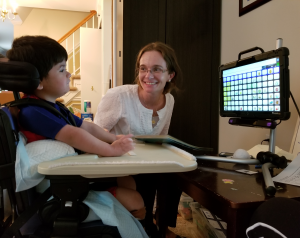 On Thursday, Joey and I stared at each other, silently. My goal in the moment was for Joey to select the word ‘want’ on his AAC eye gaze device. Joey’s goal was to get me to give him a stuffed owl he had dropped on the floor. In my perfectly planned lesson, these two goals would work together. Joey would use the device to say “want” and then I would give him the owl. Joey though, did not show any interest in selecting the ‘want’ icon.
On Thursday, Joey and I stared at each other, silently. My goal in the moment was for Joey to select the word ‘want’ on his AAC eye gaze device. Joey’s goal was to get me to give him a stuffed owl he had dropped on the floor. In my perfectly planned lesson, these two goals would work together. Joey would use the device to say “want” and then I would give him the owl. Joey though, did not show any interest in selecting the ‘want’ icon.
This battle over the word ‘want’ has been going on for four sessions now. I model using the word want and then prompt, prod, and encourage Joey to select ‘want’. In response, Joey reaches into his communicative skills to do anything he can to NOT select ‘want’.
I chose the book, Little Hoot to read with Joey because I thought it would give us a great opportunity to practice the words like, want, and play. These are all words I have not seen Joey use consistently yet, and I would like to see him start putting together two to three word phrases with his eye gaze system.
After reading the book for a few sessions, I began prompting Joey to select the word ‘want’ on his AAC device before telling me the exact item he wants. Joey was not amused. He knew that I knew exactly what he wanted. He looked at the item, looked at me, then looked back at the item. Then he made eye contact with me, tipped his head to the side, and gave me a huge smile. When that did not work, he grabbed my arm and pushed it toward the stuffed owl sitting out of his reach. I selected ‘want’ on the eye gaze. “You want the owl”. He forcefully said, “owl” verbally numerous times. But no ‘want’ button.
We have so many different ways to communicate with one another, and Joey clearly knows how to communicate his wants and needs non-verbally. There is no doubt in anyone’s mind what he wants when he decides he is going to tell you he wants something. But our goal is for him to have a rich vocabulary, and to be able to communicate effectively with anyone around him. ‘Want’ is a pretty important word to use to communicate, which is why I’d like him to use it.
But we can never forget, Joey is also three years old, and like many three year olds, he can be stubborn. He is NOT going to select the ‘want’ button if he does not want to. I know this. He knows this. So we’re at a stalemate.
The goal, of course, is for Joey’s communication to increase. So here his vocabulary is increasing, and he’s saying “owl” over and over again. But communication is more than just vocabulary, and I want him to be able to be more specific with his words. Communication is more than just labeling items, or saying something and receiving an immediate reward. Communication is about relating with others.
In this session, Joey has used his eye gaze device to correctly answer questions about the story like, “How is little owl feeling?” and to fill in the sentence of “red and yellow paint make…” He knows how to use his device.
Yet, right now, in this moment, Joey and I are not relating to each other, unless being in a heated argument counts as relating. Joey bends his head toward me and narrows his eyes. He isn’t scowling, but it does appear that he is telepathically telling me that I need to pick up the owl and put it on his tray. NOW. If only telepathy worked. I know, friend, you want to talk to me so badly.
Finally, I selected the ‘want’ icon to start Joey’s sentence, so that he could add “owl” to the end. I modeled the phrase, “You want me to get the owl. You want (I selected both words on the screen) “owl” I said verbally. I paused, “Tell me…” I pointed to the ‘want’ button. Joey scowled.
“Get owl,” he said verbally, pointing to the floor again.
Get owl? Did he just verbally put together two words to avoid using the ‘want’ icon?
I looked at his mom, who laughed and confirmed that she had always heard ‘get’.
I picked up the owl as requested.
My goal going into this was for him to use two-word phrases. He used a two word phrase. It might not have been the phrase I wanted him to use, and he might not have said it in the manner I wanted, but in what he did, he exceeded my expectations.
“UP!” he said verbally, smiling at me as he held the owl up into the air triumphantly. “Up! Up! Up!”
Yes, the owl is up. Now, if we can just get out more of those two word phrases.


